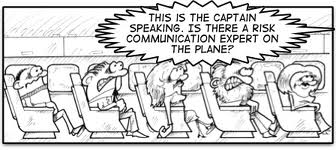There is a growing literature on risk communications, much of which is aimed at advising corporations on how to deal with the fears that their operations engender in the community. In the magazine Cash Flow David Katz writes of the increasing  need for risk communication consultants by companies with “existing or potential pollution liabilities....to help cool down the furor and thus curb their risks.” The risks he is talking about here are not the health and environmental risks to the community but the risks to the company of regulation and law suits. He suggests risk communicators could help such companies “to communicate with the press and public to sway the government and to develop strategic plans to deal with pollution regulators.”
need for risk communication consultants by companies with “existing or potential pollution liabilities....to help cool down the furor and thus curb their risks.” The risks he is talking about here are not the health and environmental risks to the community but the risks to the company of regulation and law suits. He suggests risk communicators could help such companies “to communicate with the press and public to sway the government and to develop strategic plans to deal with pollution regulators.”
Many risk communicators concentrate on developing ways to effectively explain findings of the risk assessments done by company experts, and therefore to reassure it the public:
the self-imposed task of risk communicators is to disseminate various truths to an audience that is deficient in some fundamental and obstructive way, beyond ‘ignorance of the facts’. Those to whom risk assessments need to be communicated are perceived to lack reason or be hampered by an assortment of psychological and political disabilities—bias, special interest, ideological commitment, and so forth.
Joe Epley, past president of the Public Relations Society of America, writes of the need for international public relations because “public opinion, fueled by hysteria, a desire to live in a risk-free environment, and unfounded perceptions of the industrial world, is making it difficult for many manufacturers to operate on either a local or global basis.”
Risk communication aims to correct the public’s ‘false’ view of risk. Some risk communicators acknowledge that many of the factors influencing a person’s perception of risk are quite rational, for example whether the risk is imposed or voluntary. They nonetheless seek to change perceptions rather than reduce risks. For example, Peter Sandman’s well used formula, Risk = Hazard + Outrage, is used by companies and government agencies trying to get community acceptance for hazardous facilities to work out ways to reduce outrage rather than to reduce the hazard. This is done by concentrating on communicating the concern, honesty and trustworthiness of the organisation proposing the additional risks.
For example, Stuart Price, a communications consultant who has worked for Westinghouse Electric Corporation, advises in an article on Learning to Remove Fear from Radioactive Waste that “bringing concerned citizens into the decision-making process, rather than just launching one-way information packets in their direction, is a technique that can build good will and resolve many fears.” He recommends the use of advisory boards with local residents, environmentalists and workers on them and regulators and waste generators present to provide expert advise and explain the ‘reality’ behind the newspaper headlines.
These are all suggestions that have been taken up by the Responsible Care program which was thought up by the Canadian Chemical Producers Association and is now subscribed to by chemical industries in many countries including the UK, USA and Australia. Responsible Care is aimed at restoring the declining image of the chemical industry, rebuilding trust and avoiding more regulation. It uses voluntary codes of practice, open days and public advisory panels to achieve these ends.